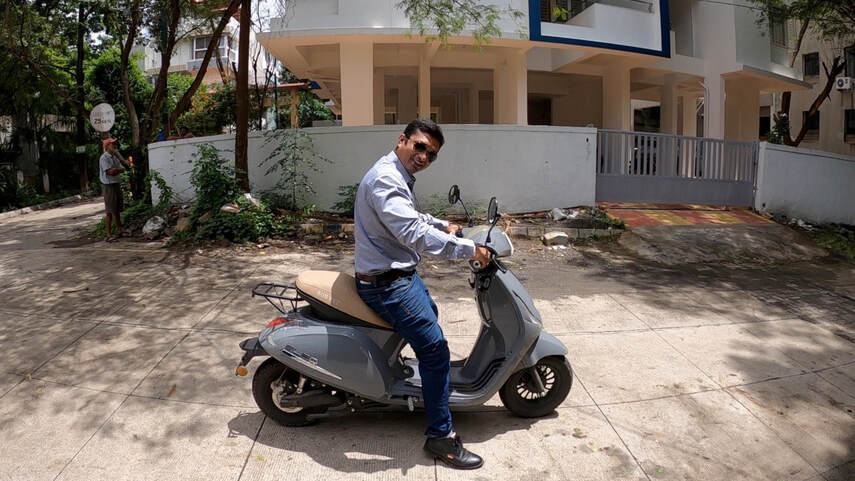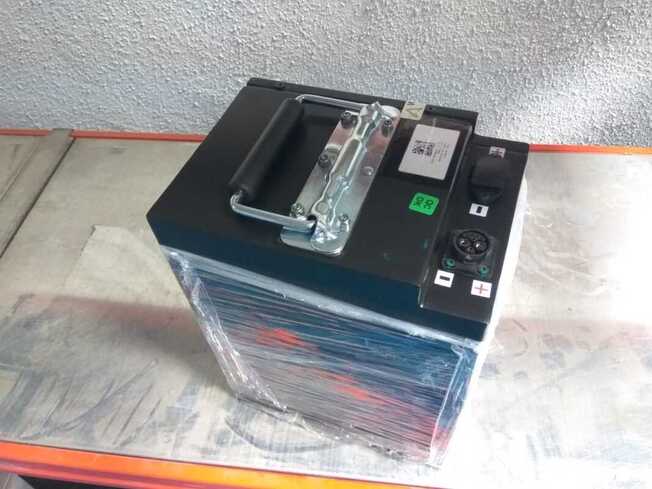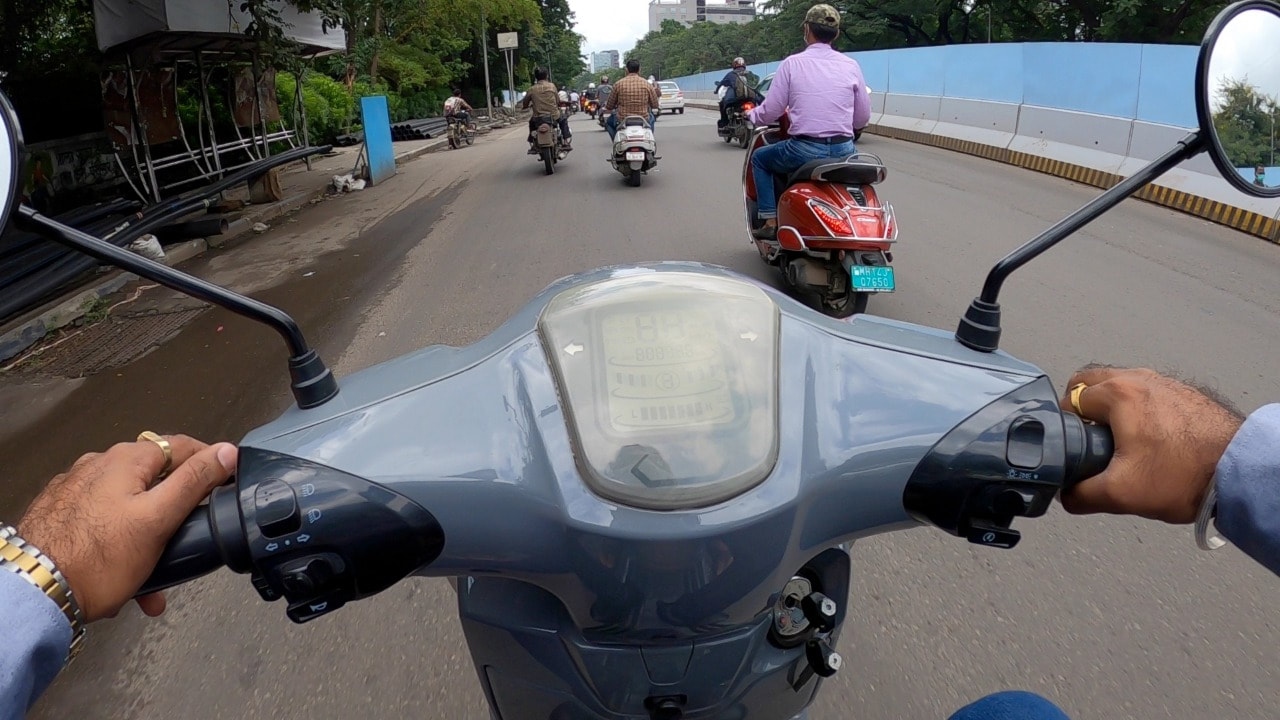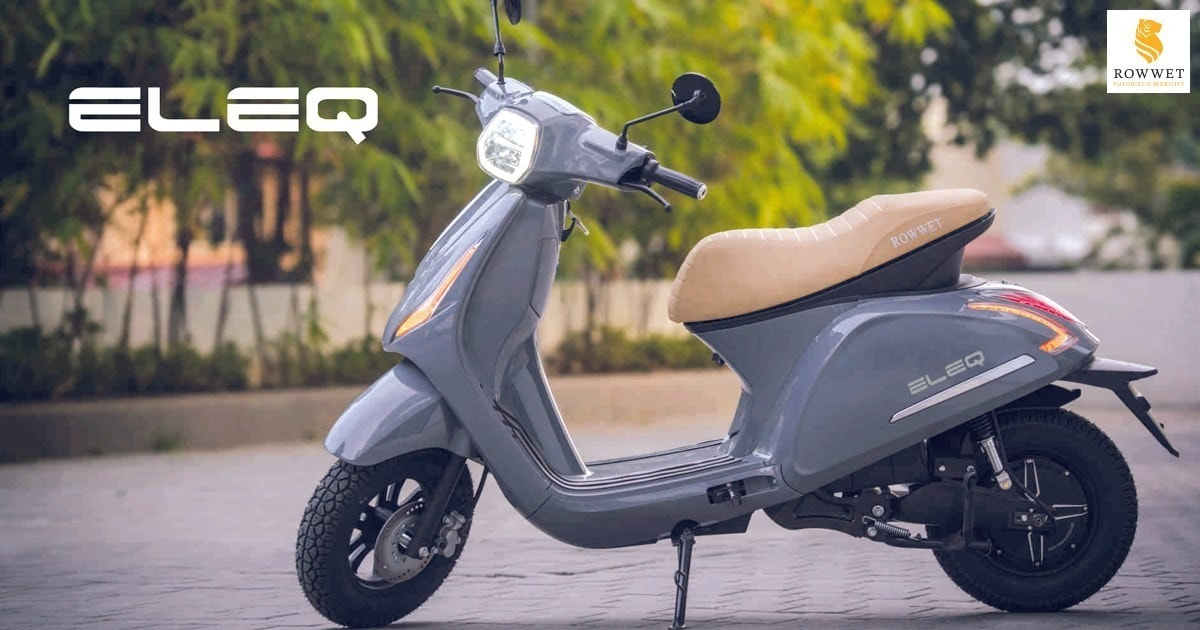By Atul Gopal
The PluginIndia team had visited a new electric two wheeler manufacturer - Rowwet Mobility. They have 4 models of electric scooters and also plan to launch some motorcycles. We got an opportunity to test the Eleq model, which is a high speed electric scooter. Here are my thoughts.
Video - Let's Ride the Rowwet Electric Scooter
Rowwett is a Pune based company. We have been in touch with their team for over two years now. I see some similarities between SB Tek, also Pune based, and Rowwett. Both come from the same real estate background. We were told that Rowwett has a manufacturing facility at Chakan near Pune. More than Rs. 20 cr has been invested in the project. The company has also purchased the dies for some of the models, so that they can start panel moulding here itself. The chassis is being manufactured in India.
The first 1500 sq ft showroom has come up in the swanky Koregaon Park area of Pune. Parking is a challenge in the area - you have to go to bylanes to get parking - and then walk down to the showroom. The distribution model is to have state level master franchisees, who appoint sub franchisees in different cities, towns and villages of a state. The master franchisee also looks at supplying to multi brand outlets, a channel which accounts for bulk of the EV sales today.
There are 5 vehicles that were in the showroom. The Vegatron is a Honda Dio look alike. It has a 3 kW motor - and is zippy. The one that I rode ad some stability issues. Maybe a loose nut in the suspension. It has a tunnel going through the floorboard, which looks quite neat - reminds me of the old Bajaj scooters design - where the monocoque body was strengthened using a similar tunnel. But this will be a liability for the small businessman looking at investing in this vehicle. It will not allow easy loading in the floorboard area. My hypothesis is that the likes of Kinetic Honda and later on Activa killed the Bajaj simply because they had flat floorboards. There is a low speed model, Zepop, which looks very much like the SB Tek model. The demand for this vehicle is the highest - thanks to a lower price - and the lack of RTO formalities. The lead acid version is priced at 52 K. The Rame is a high speed model with a 2 kW motor.
The first 1500 sq ft showroom has come up in the swanky Koregaon Park area of Pune. Parking is a challenge in the area - you have to go to bylanes to get parking - and then walk down to the showroom. The distribution model is to have state level master franchisees, who appoint sub franchisees in different cities, towns and villages of a state. The master franchisee also looks at supplying to multi brand outlets, a channel which accounts for bulk of the EV sales today.
There are 5 vehicles that were in the showroom. The Vegatron is a Honda Dio look alike. It has a 3 kW motor - and is zippy. The one that I rode ad some stability issues. Maybe a loose nut in the suspension. It has a tunnel going through the floorboard, which looks quite neat - reminds me of the old Bajaj scooters design - where the monocoque body was strengthened using a similar tunnel. But this will be a liability for the small businessman looking at investing in this vehicle. It will not allow easy loading in the floorboard area. My hypothesis is that the likes of Kinetic Honda and later on Activa killed the Bajaj simply because they had flat floorboards. There is a low speed model, Zepop, which looks very much like the SB Tek model. The demand for this vehicle is the highest - thanks to a lower price - and the lack of RTO formalities. The lead acid version is priced at 52 K. The Rame is a high speed model with a 2 kW motor.
The high point of Rowwett is the Click battery, which can do a full charge in 12 minutes. I thought initially that it was a supercapacitor based battery. This battery weighs about 30 kg. The cells are being imported from Taiwan and assembled by Rowwet. Gegadyne is a Mumbai based company in the same supercapacitor space. I listened to a TED talk by their founder - and realised that what they are selling is a hybrid pack - very similar to what my friend Vijay Chheda has been trying to do for many years in the ICE space - without too much success.
The battery capacity looked to be like 2 kWh. This is premised on the math of having a 10 kW actual power flow into the battery. In 12 minutes, or 1/5th of an hour, one can expect about 1.8 kWh of energy going in. There should have been a total of 12 capacitors. So each of them can store about 0.15 kWh or 150 Wh of energy. Assume that each of them operates at 6 V, so we can say that each is rated for 150/6 = 25 Ah. 1 Ah is 3600 Coulomb. So we are looking at 3600*25 = 90,000 Coulomb. Divide this by 6 V to get the Farad rating of each cell - you get 90,000/6 = 1500 F. I googled and 1500 F capacitors are available. But there are none rated at 6 V. So this makes the supercapacitor hypothesis a little difficult to sustain.
The battery capacity looked to be like 2 kWh. This is premised on the math of having a 10 kW actual power flow into the battery. In 12 minutes, or 1/5th of an hour, one can expect about 1.8 kWh of energy going in. There should have been a total of 12 capacitors. So each of them can store about 0.15 kWh or 150 Wh of energy. Assume that each of them operates at 6 V, so we can say that each is rated for 150/6 = 25 Ah. 1 Ah is 3600 Coulomb. So we are looking at 3600*25 = 90,000 Coulomb. Divide this by 6 V to get the Farad rating of each cell - you get 90,000/6 = 1500 F. I googled and 1500 F capacitors are available. But there are none rated at 6 V. So this makes the supercapacitor hypothesis a little difficult to sustain.
One of the dealer revenue models that was discussed for the Click batteries is to provide charging aka petrol bunks to the Rowwett gaddi owners. The 2 options that were discussed: Rs. 999 per month - an unlimited as much energy as you want. Or alternately, a Rs. 50 per charge. People who want a daily charge would prefer the monthly model, but users whose ride cycles are shorter, may go in for the per charge pricing.
We got the vehicle at the end of Pune's bumper rainfall week, so we could not ride it as much as we should have. There are dozens of Vespa EV look-alikes in the market today. The Elek fits into that category, but kinda stands half a head above the other Vespa competition in the looks department. It has got reasonably different styling - and though it may not be a head turner, it does appeal to a higher aesthetic. The indicator form factor is something that resembles the Chetak indicators, but I would rate the Eleq ones better in form. In night driving the LED headlights are mediocre, though I liked the Chetak type Driving Running lights (DRL), which remain on all the time.
A 2 kW motor sits on the rear wheel hub - and powers a good zippy ride in city traffic. In my 2 days if usage in city traffic, I decided to relive the days of my youth and only got overtaken twice. That was so unnatural for a person who is on cycles most of the time. The Eleq is touching Ather territory with the motor, but being a hub drive, top speed is not as high, between 55 to 60 kmph, which is Ok for intra-city use, but not good enough for highways. That segment will be dominated by motorcycles for some time to come.
The rear wheel is housed in a lovely Aluminium cast swing arm which leads to improved ride quality as the scooter can handle potholes much better. Though paint quality near the swing arm area can be improved. We saw some rusting there.
The battery is 72 V, 28 Ah, which means that it packs in a shade above 2.5 kWh. All the Rowwett batteries work on 72 V. The higher the voltage, the better it is for battery efficiency, as current drops and IsquareR losses fall. Uses NMC chemistry. We could not do a full range test because of the continuous drizzle that we had during the testing period, but my guess is that a 2 kWh battery should get you a range of around 70-90 km. Still not close to the magic century figure that a lot of buyers want in their gaadis nowadays. What helps range is a default setting of starting in mode 2. Top speed is 45 kmph in that mode, which is good enough for 90% of city commuting. I liked the push button toggle switch to select mode. And the hazard light switch.
A big battery means smaller dicky space - and that's a compromise that most EV users would live with. It is too heavy for swapping, and I tried hard but could not get it out of the battery Box.
You need to have good stowage arrangements in the footrest area when dicky space is less. There is a bag hanger but I had trouble getting two bags hanging out of it during my veggie shopping visit. I usually buy 20 kg of fruits and veggies in one trip - and had trouble keeping all that on the floorboard. I also think that it's not going to pass the gas cylinder stowage test. To the floorboard's credit, it has rubber beads running along them which help get good friction for bags and the feet. That's an old Bajaj / Vespa scooter design - and not too many electric vehicles have adopted this feature.
What disappointed me the most was the seat ergonomics. On the face of it the seat looks good - but it has a tendency to push you towards the front, so you seem to be literally at the seat's edge all through the drive. I also rode pillion - and got the same feeling where there was an insecure feeling that you could fall off the seat. A taller back support can help get over that. There is some stowage area at the rear, but I would have been happier if that area had been used up for a seat. The current design sees the rear occupant cantilvered beyond the frame of the scooter. Not sure of how much you can extend this cantilever.
The pricing at Rs. 0.83 lakh is affordable, especially when compared to Chetak and Ather which reside in 1.5 lakh territory. The seat is one of the easiest items to localise. If we look at an evolutionary approach to adapting Chinese scooters to Indian markets the beginning will have to be made with seats. I would wait for Rowatt to do that before I plonk in the moolah for this gaddi!
We got the vehicle at the end of Pune's bumper rainfall week, so we could not ride it as much as we should have. There are dozens of Vespa EV look-alikes in the market today. The Elek fits into that category, but kinda stands half a head above the other Vespa competition in the looks department. It has got reasonably different styling - and though it may not be a head turner, it does appeal to a higher aesthetic. The indicator form factor is something that resembles the Chetak indicators, but I would rate the Eleq ones better in form. In night driving the LED headlights are mediocre, though I liked the Chetak type Driving Running lights (DRL), which remain on all the time.
A 2 kW motor sits on the rear wheel hub - and powers a good zippy ride in city traffic. In my 2 days if usage in city traffic, I decided to relive the days of my youth and only got overtaken twice. That was so unnatural for a person who is on cycles most of the time. The Eleq is touching Ather territory with the motor, but being a hub drive, top speed is not as high, between 55 to 60 kmph, which is Ok for intra-city use, but not good enough for highways. That segment will be dominated by motorcycles for some time to come.
The rear wheel is housed in a lovely Aluminium cast swing arm which leads to improved ride quality as the scooter can handle potholes much better. Though paint quality near the swing arm area can be improved. We saw some rusting there.
The battery is 72 V, 28 Ah, which means that it packs in a shade above 2.5 kWh. All the Rowwett batteries work on 72 V. The higher the voltage, the better it is for battery efficiency, as current drops and IsquareR losses fall. Uses NMC chemistry. We could not do a full range test because of the continuous drizzle that we had during the testing period, but my guess is that a 2 kWh battery should get you a range of around 70-90 km. Still not close to the magic century figure that a lot of buyers want in their gaadis nowadays. What helps range is a default setting of starting in mode 2. Top speed is 45 kmph in that mode, which is good enough for 90% of city commuting. I liked the push button toggle switch to select mode. And the hazard light switch.
A big battery means smaller dicky space - and that's a compromise that most EV users would live with. It is too heavy for swapping, and I tried hard but could not get it out of the battery Box.
You need to have good stowage arrangements in the footrest area when dicky space is less. There is a bag hanger but I had trouble getting two bags hanging out of it during my veggie shopping visit. I usually buy 20 kg of fruits and veggies in one trip - and had trouble keeping all that on the floorboard. I also think that it's not going to pass the gas cylinder stowage test. To the floorboard's credit, it has rubber beads running along them which help get good friction for bags and the feet. That's an old Bajaj / Vespa scooter design - and not too many electric vehicles have adopted this feature.
What disappointed me the most was the seat ergonomics. On the face of it the seat looks good - but it has a tendency to push you towards the front, so you seem to be literally at the seat's edge all through the drive. I also rode pillion - and got the same feeling where there was an insecure feeling that you could fall off the seat. A taller back support can help get over that. There is some stowage area at the rear, but I would have been happier if that area had been used up for a seat. The current design sees the rear occupant cantilvered beyond the frame of the scooter. Not sure of how much you can extend this cantilever.
The pricing at Rs. 0.83 lakh is affordable, especially when compared to Chetak and Ather which reside in 1.5 lakh territory. The seat is one of the easiest items to localise. If we look at an evolutionary approach to adapting Chinese scooters to Indian markets the beginning will have to be made with seats. I would wait for Rowatt to do that before I plonk in the moolah for this gaddi!




